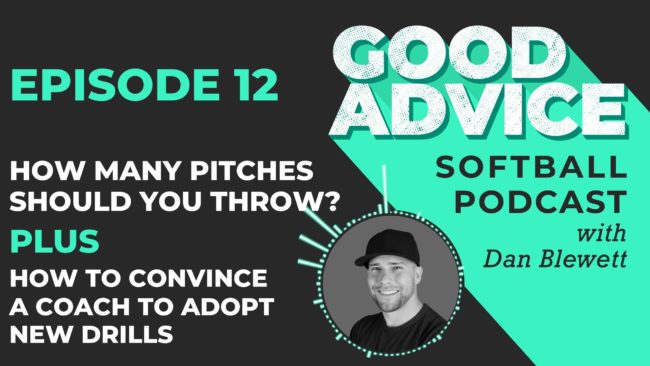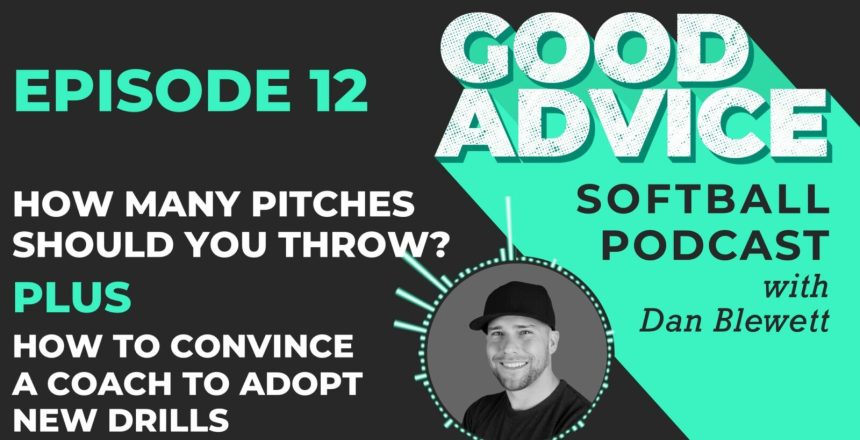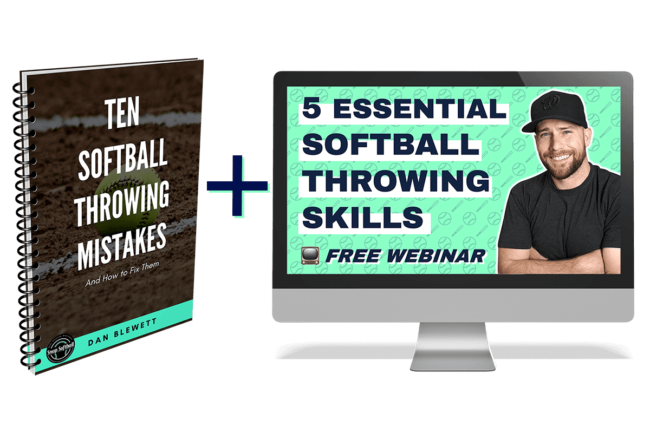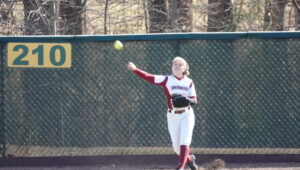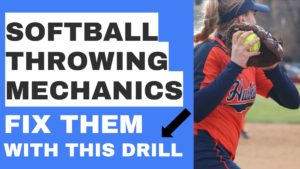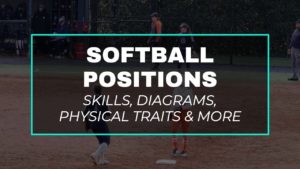*This article may contain product links which pay me a small commission if you make a purchase. Learn more.
How many pitches should a pitcher throw? 4? 5? 6? What about 3? Why does a pitcher throw each type and what’s the purpose of each? And, Dan covers how to convince coaches to adopt “new school” throwing drills that conflict with older teachings. Many coaches teach what they were taught, but we have to get away from this and sometimes it takes a lot of convincing.
To submit a question for the Good Questions Q&A segment, make a voice recording and email it to Dan at hello@danblewett.com.Want to support the show? Enroll in one of Coach Dan’s online throwing courses or his mental skills course. Use code GOODADVICE to save 20% on any course, just for being a listener.Sign up for Dan’s Email list and get his free throwing eBook, and follow up with him on the interwebs: YouTube Channel | Twitter | Snapsoftball.com
Podcast: Play in new window | Download
Subscribe: Apple Podcasts | Spotify
Full Transcript: EP12 Good Advice Softball Podcast: How Many Different Pitches Should a Pitcher Throw and How Do You Convince a Coach to Adopt New Throwing Drills?
You are listening to the good advice, softball podcast. I’m Dan Blewett. And on this show, you’ll learn how to help the softball player in your life. Sharpen her skills, improve her mindset and find new confidence through softball.
All right. Welcome back to the good advice softball podcast. I’m Dan Blewett. And in today’s episode, we’re going to talk about what we’ll cover our typical three topics. Number one, how many pitches do you need to throw off your pitcher? That’s something I sometimes get a little fired up about number two.
What, how should we grip us off? Well, when we’re throwing it in an infield, um, or in the infield, uh, number three, our Q and a is. How do I help convince an assistant or a head coach that we need change in our drills, that we shouldn’t continue to teach the old stuff that we’ve been teaching. So I got that question via email recently, and I’d like that I’d like to address that for all my listeners here.
All right. So first, how many pitches do you need? And this was a conversation I had with a father in my program. I’d say probably four years ago. And I was asking, I was watching his daughter pitch and she threw like five or six pitches and I’m like, Hey, why does she throw five pitches? What are the different pitches she throws?
And he’s like, well, I was got a fastball rise ball, change up curve, drop curve. I think there’s another one. I’m like, why, why did she throw six pitches? Like she’s 15. Like, like why he’s like, Oh, well, you know, we have this one for this reason and this one. And I’m like, they weren’t, I’m like, well, why would you throw a curve instead of a drop curve?
And he’s like, well, this one breaks away. I’m like, yeah, you’re describing the difference between the two pitches, but why would you throw it, um, in, in one situation versus another to one? Like, why would you throw it? And I use in this whole discussion, I use the analogy of tools a lot. So like actual, like compare it to a saw or a screwdriver or whatever.
I think this is a really. Apt analogy. Imagine you’re a carpenter and you have six different little handsaws. Why do you have six, six handsaws, right? Maybe you have a power saw. Maybe you have like a . Maybe you have a circular saw and maybe have one hand Saul. That’s good for like rough cuts and one that’s good, fine cuts.
Um, but in general, I know you probably wouldn’t need six variations of the same tool. Right. Um, and I think that in general rings true most of the time, if you’ve one really nice, expensive, uh, power drill, you probably don’t need two more, slightly cheaper power drills. Do you. Maybe if you’re like, you know, a home, a home builder, you have a couple as a backup, but really if that one works, you’re going to use it every day until it’s dead and then you get a new one.
And so my point here is that with breaking walls, especially what, what hitter is going to get a curve instead of a drop curve. What situation is going to merit a curve instead of a drop curve and are the two pitches exactly the same in quality. That’s never the case. So basically what you have is you have six different pitches that all have different roles, potentially many of which are ambiguous, because again, why you would choose to throw a curve and sort of a drop curve is probably a, just an arbitrary choice.
Now you’re going to say, Oh, well, this girl, who’s 15 years old from some random town, Missouri. Uh, I don’t think she can hit a curve that breaks straight down versus a curve that breaks a little bit away from her body. Like, it sounds ridiculous. Right? Even the big leagues, it’s not like we have scouting reports, um, on major league baseball players who say, yeah, he can hit a curve.
That’s a straight down, but he can’t hit a curve. That’s got a little bit of lateral break. Like that’s not a thing. And so. You know, pitchers will invent a pitch later in their career. Like they’ll add a new pitch that has a defined role. So maybe a pitcher has, you know, a curve. Um, and then later they’re like, Hey, I could get righties out better.
If I added, if I added a, you know, a slurve or I added a slider or a drop curve or something like that, really, they don’t throw sliders in, in, uh, in softball. Um, you might add a pitch that has a very specific need that fills a hole in your repertoire, but often with young players, They don’t locate that.
Well, you know, low, low softball players, they’re still learning to make their pitches spin better to make them break sharper. Right. They’re still learning to command and the strikes and with all of them and yeah, and they’re just learned to like pitch in general and read hitters and do all those other things.
So when you have so many different pitches, number one, when you practice, you can only practice. If you throw 90 pitches in a practice session, which is a lot, if you have six pitches, that’s only 15 or apps for each one, If you throw three pitches, now you’re going to get 30 throws for each one. So each of those three pitches are going to get more attention, more reps, more refinement, because you simply get to spend more time with it.
Just like if you’re a family of 10 children, your kids are going to get exponentially less quality time with mom and dad. Then if you have two children, doesn’t make the family better or worse. It’s just a fact that you get to spend less quality time. If you have a massive family, you know, just, you can only spread out so far with two parents for the Brady bunch.
Now it’s the same thing with pitching. If you have six pitches, you can only make so many throws in a week. And that means you can only spend so much time on each individual pitch. And so they’re all going to be less high quality because of contact time with each one, compared if you only had a couple pitches.
And this is my other big point is say, you had, you know, say you were building a house and you have the screwdriver, like a hand screwdriver and you have a power drill that has a screwdriver attachment. Which one are you going to use? You’re gonna run around hand screwing in screws all day. No, you can use the power drill and you’re probably never going to use the hand screw or the hand screwdriver or the Phillips head or whatever.
Except in a tight spot or maybe the drill can’t fit. Right. And so that’s sort of how it is. So, so imagine you have a drop curve and a regular curve and the drop curve is nasty. Like it’s really sharp. It’s really good pitch. And the regular curve is not that good. Why would you ever choose the, not that good version over the good version?
Like, why would you choose the crappier version? It’s like, why would you run around all day hand screwing in screws to build a house when you get to use the power drill. And that’s kind of how this comes down to. So if you have six pitches, They’re going to all grade out differently. Like one might be nasty.
Another one might be pretty darn good. And then the next three might be just kinda mediocre. So why use the mediocre three? If you could just dominate people with fast ball, change up drop curve for whatever. Right. And then as you start to get really good with them, and then you start to see hitters adjust, then maybe you can add a fourth pitch that says, okay, well, If I add this other pitch, it’ll fill this need.
It’ll fill this gap, like maybe at a rise ball, and now you can beat hitters up. You can be hitters down, you can, you know, beat him with a change of speeds, whatever. So without commenting specifically on any specific repertoire or any given individual pitch, you just need to take into account. Am I throwing too many mediocre pitches.
And if I took two out of my repertoire and focus more of my effort and time on the remaining three or the meaning for a, would each of them improve faster because I can spend more time with them. The answer is going to be, yes, it’s just, it’s just going to be because of you throw, you know, if one pitcher throws 10,000 drop curves in her life and practice, and another pitcher throws 3000 drop curves in her life, which one’s going to be better.
The girl through 10,000 of them, right? It’s just practice. There is as much as there’s some innate talent, there’s a lot of just, you have to practice more and practice better than the next player. And so we all understand that too, right? Hits, hits, and hits and hits all the, all the time off the cage. It’s all the time off the tee is constantly working on our swing.
It’s going to be a better hitter than the girl who’s doesn’t right. And there’s going to be some individual differences, her vision, just all those things, but. All things the same. If you had two identical humans, one practice, more, one practice, less the practice of the one who prizes more is better. So that’s where I think this argument comes down to.
And I think more people need to hear that because having pitched at a high level in baseball myself, you don’t need massive amounts of pitches to succeed. And there’s no reason the rules are different for softball. It’s not like softball hitters are so much more advanced, uh, where, you know, they have to have, if you don’t throw a six pitch repertoire, you can’t get ’em out.
Not true. You throw two special pitches. Like you throw really hard, have a really nasty change up, you get through a game like that. And then you start to add other really high quality pitches and it just makes it even easier. But again, When I see young players, I just, I question the understanding of what each pitches for, like, if you have a sixth pitch, does it really have a specific purpose when you’re facing 15 year old girls or 17 year old girls who aren’t really that good at hitting, um, answer usually no.
So something to consider, how big is your repertoire and does every pitch in it make sense for you? Alright, it’s time for good questions. Our listener Q and a segment. Remember if you have a question you’d like answered on the show, please email a voice recording to hello@danblewett.com. This is easy to do on your phone through the voice memos app on iPhones or any voice recorder app on Android links to email me are in the show notes.
All right. In our Q and a today, I got an email recently, uh, and it was someone who has been watching my YouTube channel and they said, Hey, we’ve watched a lot of, I’m going to implement a couple of them with my players and their throwing routines. Uh, but my assistant coach who’s otherwise very helpful.
Isn’t really very helpful when it comes to this, he kind of believes that we should still be doing these old school drills. He thinks some of your Joel’s are for younger kids, not really for older players, like 14, 16, you, um, can you help me convince him? So number one, throwing drills. So if you, if you do watch my YouTube channel and none of those drills are for a little girls versus older girls.
Did it, that’s not how it works. They’re just for humans that throw a ball. So whether you’re 10 or whether you’re 18, I might sell that. Use the same drill with you. If it has a specific purpose too. Basically fix a certain mechanical flaw. Now there’s some drills that are easier for ten-year-olds to do that are a little, or that are easier for them to do because they’re kind of complex, uh, or that I have other drills that are too complex.
Um, so sure there are simpler. Joel’s more suitable for younger kids and then they’re more complex drills for older kids, but it doesn’t mean one’s built for the other or not. I just, I just won’t give. A drill. That’s a little bit hard for a 10 year old to do. I won’t give them that one. I’ll give him a different one.
Whereas with a 17 year old, they can do any drill. And I know that their athleticism and body control will be a little bit easier for them to do any of them. So don’t think of drills as being aid specific as they’re really not. I mean, if I, I don’t think I’ve ever done a drill that was specifically made for a younger player.
I just have a whole catalog of jewels use for any player. And then for some kids, whether they’re too young or their body control is poor, or it’s just not appropriate for them yet because they have other stuff work on, then maybe I’ll say, all right, drills are too advanced for you, but I’ve never S never said this drill is too simple for you.
There are some drills where we’ll try it. And then after like make five or six throws, maybe a player’s like pretty good at it. And they’ve accomplished what I wanted them to accomplish and we’ll move on. That certainly happens a good amount, whereas maybe a 10 year old given drill a, has to spend a week doing it.
Whereas the same drill given to an athlete who is 17 only spends half a day on it. Who knows like those, the differences, but there really isn’t anything like, Oh, this is too easy for an older player. And the other thing I would add is, uh, that most softball players don’t throw well, even when they’re older, So the idea that a basic throwing drill wouldn’t be appropriate for a 18 year old is false because I, I go to D one games and see division one softball players who have poor throwing mechanics just to put it quite frankly, poor throwing mechanics where if it weren’t for the, of the softball field is so small and the pace of the game is so fast.
And that getting rid of the wall quicker is sometimes more important than throwing it hard. That’s the only reason that it’s acceptable. Like it would never work in baseball where the, the speed of the game is faster. As far as how fast runners actually run and the distances are much longer. Um, you couldn’t possibly hack it on a bigger field, making long throws with such poor mechanics.
That’s just an unfortunate, obvious objective state of the industry that many players get away with poor throwing mechanics, because the field is so small and there are otherwise pretty physical and they can still get the ball across the infield. In a fast enough manner. Um, so that’s one of the big things.
There are no drills and, uh, that are age specific really. And really, they could always be specific to older players, as long as it’s addressing the right thing in their mechanics. As far as approaching people who are resistant to change, that’s a challenge. And I think one of the things is, is letting them talk through their nerves about switching to the new stuff when people can voice their concerns and be genuinely heard.
So that means being a good listener that means responding well and saying, Oh, so. You know. All right. So what what’s, uh, what problem do you have with, uh, with some of these new drills? Oh, I just think they’re a fad. I think they’re not, as, you know, they haven’t been time tested. So you think, you know, getting a lot of repetition is important.
Yeah. I think things need to be tested over a long period of a couple of years or 10 years or a couple of decades or whatever it’s like. Okay. Well, wouldn’t you agree that we’ve had some advances in medicine that have maybe not been tested since. A couple of decades ago. Oh yeah. That could be true. I don’t know.
Obviously these are long conversations to convince people to change long-held views, but there’s two main strategies that I would give. Number one would be not coming at them with why questions, why questions tend to make people defensive? Why did you do that? Sounds very different than what did you do that for?
Those are two very different questions. The word why just puts people on edge a little bit. Um, and what questions really address more of reasons. Whereas why is like challenging just in general? Like why do you believe that? Or like, what are your reasons for believing that they just w the what question is much more general?
So I would always tend to avoid why questions possible and go to what’s when trying to get to get to the root, the root cause of something. And a lot of times it’s coaches who are resistant to change. They don’t want to learn all these new drills. They don’t want to do the homework. They don’t want to put in the effort.
They don’t want to feel uncomfortable that they can’t coach it because they don’t know it very well yet. Um, that’s a big thing. Lots of people are just resistant to change in general. And so they’ll use. These floppy excuses of, Oh, this hasn’t been around that long or this other thing is time tested.
It’s like to be quite Frank, the throwing drills and salt. Well, our absolute trash, like all of them, pretty much all of them are trash from all these years. And it’s not like the throwing drills that I use, which have come from many various sources in baseball. There are some that I learned as a kid.
There’s some, I learned as a college player, there’s someone as a pro player. There are many I learned from other coaches. Um, There’s nothing incredible and crazy about these drills either. They’re just not trash. Like they’re actually functional drills that have been used. Lots of pictures and developing baseball pitches, a very high dollar industry.
You make $20 million a year. Now, if you’re an average big league starter. So. The fact of the matter just is that softball drills that are being passed down from 10, 20, 30 years ago are just terrible. If you watch it, a lot of old instruction on YouTube, you know, you can find videos that are five, 10 years old.
The things they’re teaching are just patently incorrect. They’re false, they’re wrong. They’re not taught the right way. So, you know, it does take a culture shift that does take. Showing evidence. I think video is hard to get past. If you have some video, if you use mine, whatever that’s important, but some people are just resistant to change and it just takes time.
But I think the overarching thing is listening to them so they can say, okay, I’ve said my piece. This is why I think we should stay with the old stuff that doesn’t work. Um, Now, maybe I can listen to this guys pitch about what these new Jules have to offer. That’s how people will eventually adopt change, especially when they’re being pretty stuck in their ways.
And honestly, sometimes you just won’t ever convince them, but you know, it’s always worth a try because softball really does need the culture shifts. And throwing education. Well, that’s all the good advice I’ve got for today. If you enjoy the show and would like to support me while also helping yourself enroll today in one of my online softball courses, my she’s got a cannon throwing courses, come with pricing plans for any budget.
And my resolute athlete, mental skills course will help your daughter or team build the mindset of a champion. Enroll in any of my courses through the links in the show notes and save 20% with code good advice just for being a listener. Be sure to subscribe to my weekly email list where you’ll get updates on all my new videos and episodes, nearly 4,000 people get my emails and you should to sign up for the link in the show notes.
Lastly, who do you know, who can use some good advice? Please share this podcast with a friend, subscribe on iTunes, Spotify, or wherever you listen to podcasts and subscribe to my snap softball, YouTube channel, where you’ll find this podcast and hundreds of softball, instructional videos. Back when I was a player, I was always thankful for good coaches and good advice.
I’m Dan Blewett and I’ll see you next time.

